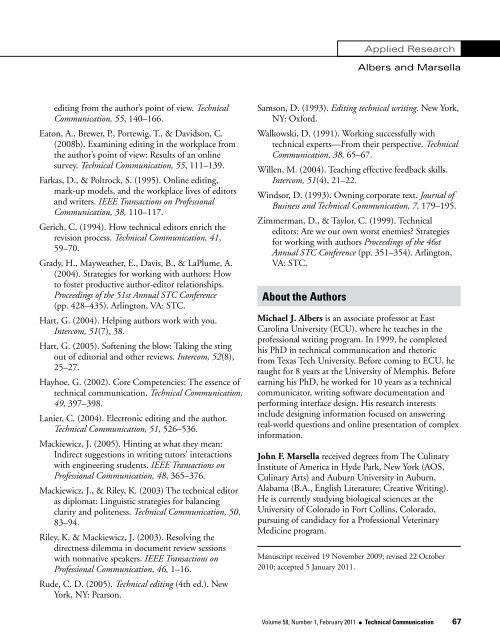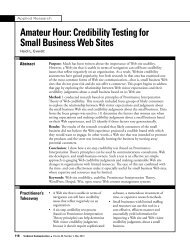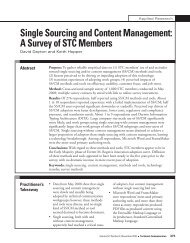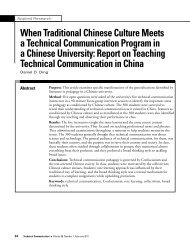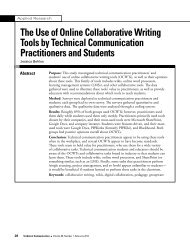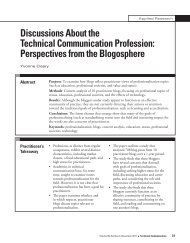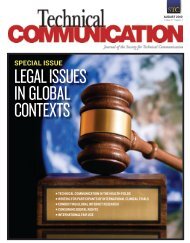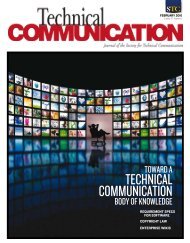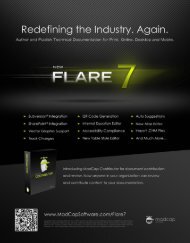An Analysis of Student Comments in Comprehensive Editing
An Analysis of Student Comments in Comprehensive Editing
An Analysis of Student Comments in Comprehensive Editing
You also want an ePaper? Increase the reach of your titles
YUMPU automatically turns print PDFs into web optimized ePapers that Google loves.
Applied ResearchAlbers and Marsellaedit<strong>in</strong>g from the author’s po<strong>in</strong>t <strong>of</strong> view. TechnicalCommunication, 55, 140–166.Eaton, A., Brewer, P., Portewig, T., & Davidson, C.(2008b). Exam<strong>in</strong><strong>in</strong>g edit<strong>in</strong>g <strong>in</strong> the workplace fromthe author’s po<strong>in</strong>t <strong>of</strong> view: Results <strong>of</strong> an onl<strong>in</strong>esurvey. Technical Communication, 55, 111–139.Farkas, D., & Poltrock, S. (1995). Onl<strong>in</strong>e edit<strong>in</strong>g,mark-up models, and the workplace lives <strong>of</strong> editorsand writers. IEEE Transactions on Pr<strong>of</strong>essionalCommunication, 38, 110–117.Gerich, C. (1994). How technical editors enrich therevision process. Technical Communication, 41,59–70.Grady, H., Mayweather, E., Davis, B., & LaPlume, A.(2004). Strategies for work<strong>in</strong>g with authors: Howto foster productive author-editor relationships.Proceed<strong>in</strong>gs <strong>of</strong> the 51st <strong>An</strong>nual STC Conference(pp. 428–435). Arl<strong>in</strong>gton, VA: STC.Hart, G. (2004). Help<strong>in</strong>g authors work with you.Intercom, 51(7), 38.Hart, G. (2005). S<strong>of</strong>ten<strong>in</strong>g the blow: Tak<strong>in</strong>g the st<strong>in</strong>gout <strong>of</strong> editorial and other reviews. Intercom, 52(8),25–27.Hayhoe, G. (2002). Core Competencies: The essence <strong>of</strong>technical communication. Technical Communication,49, 397–398.Lanier, C. (2004). Electronic edit<strong>in</strong>g and the author.Technical Communication, 51, 526–536.Mackiewicz, J. (2005). H<strong>in</strong>t<strong>in</strong>g at what they mean:Indirect suggestions <strong>in</strong> writ<strong>in</strong>g tutors’ <strong>in</strong>teractionswith eng<strong>in</strong>eer<strong>in</strong>g students. IEEE Transactions onPr<strong>of</strong>essional Communication, 48, 365–376.Mackiewicz, J., & Riley, K. (2003) The technical editoras diplomat: L<strong>in</strong>guistic strategies for balanc<strong>in</strong>gclarity and politeness. Technical Communication, 50,83–94.Riley, K. & Mackiewicz, J. (2003). Resolv<strong>in</strong>g thedirectness dilemma <strong>in</strong> document review sessionswith nonnative speakers. IEEE Transactions onPr<strong>of</strong>essional Communication, 46, 1–16.Rude, C. D. (2005). Technical edit<strong>in</strong>g (4th ed.). NewYork, NY: Pearson.Samson, D. (1993). Edit<strong>in</strong>g technical writ<strong>in</strong>g. New York,NY: Oxford.Walkowski, D. (1991). Work<strong>in</strong>g successfully withtechnical experts—From their perspective. TechnicalCommunication, 38, 65–67.Willen, M. (2004). Teach<strong>in</strong>g effective feedback skills.Intercom, 51(4), 21–22.W<strong>in</strong>dsor, D. (1993). Own<strong>in</strong>g corporate text. Journal <strong>of</strong>Bus<strong>in</strong>ess and Technical Communication, 7, 179–195.Zimmerman, D., & Taylor, C. (1999). Technicaleditors: Are we our own worst enemies? Strategiesfor work<strong>in</strong>g with authors Proceed<strong>in</strong>gs <strong>of</strong> the 46st<strong>An</strong>nual STC Conference (pp. 351–354). Arl<strong>in</strong>gton,VA: STC.About the AuthorsMichael J. Albers is an associate pr<strong>of</strong>essor at EastCarol<strong>in</strong>a University (ECU), where he teaches <strong>in</strong> thepr<strong>of</strong>essional writ<strong>in</strong>g program. In 1999, he completedhis PhD <strong>in</strong> technical communication and rhetoricfrom Texas Tech University. Before com<strong>in</strong>g to ECU, hetaught for 8 years at the University <strong>of</strong> Memphis. Beforeearn<strong>in</strong>g his PhD, he worked for 10 years as a technicalcommunicator, writ<strong>in</strong>g s<strong>of</strong>tware documentation andperform<strong>in</strong>g <strong>in</strong>terface design. His research <strong>in</strong>terests<strong>in</strong>clude design<strong>in</strong>g <strong>in</strong>formation focused on answer<strong>in</strong>greal-world questions and onl<strong>in</strong>e presentation <strong>of</strong> complex<strong>in</strong>formation.John F. Marsella received degrees from The Cul<strong>in</strong>aryInstitute <strong>of</strong> America <strong>in</strong> Hyde Park, New York (AOS,Cul<strong>in</strong>ary Arts) and Auburn University <strong>in</strong> Auburn,Alabama (B.A., English Literature; Creative Writ<strong>in</strong>g).He is currently study<strong>in</strong>g biological sciences at theUniversity <strong>of</strong> Colorado <strong>in</strong> Fort Coll<strong>in</strong>s, Colorado,pursu<strong>in</strong>g <strong>of</strong> candidacy for a Pr<strong>of</strong>essional Veter<strong>in</strong>aryMedic<strong>in</strong>e program.Manuscript received 19 November 2009; revised 22 October2010; accepted 5 January 2011.Volume 58, Number 1, February 2011 l Technical Communication 67


